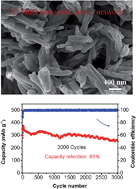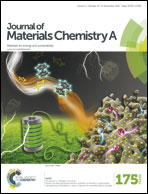Hierarchical three-dimensional MnO nanorods/carbon anodes for ultralong-life lithium-ion batteries†
Abstract
MnO anode materials with high energy densities for lithium-ion batteries (LIBs) face significant challenges in avoiding inferior reversible capacity and fast capacity fading. Here we demonstrate a facile and scalable approach to realizing excellent performance, overcoming such disadvantages. A well-connected three-dimensional (3D) hierarchical porous-conducting framework, consisting of MnO nanorods conformally encapsulated by a nitrogen-doped carbon network, was synthesized via an in situ polymerization of polyaniline into manganese dioxide along with thermal calcination. Such a structure possesses a continuous electrically conductive carbon network with porous spaces for volume expansion of MnO rods, and the carbon coating on the nanorods further alleviates pulverization and self-aggregation of the active materials. As an anode, it demonstrates a reversible capacity as high as 798.6 mA h g−1 after 5 cycles at 50 mA g−1, beyond the theoretical capacity of MnO, and an extremely stable cycle life of 3000 cycles with ∼95% capacity retention, even at a high current density of 4000 mA g−1. Significantly, the electrochemical behavior of this novel material was also probed by an in situ XRD technique.


 Please wait while we load your content...
Please wait while we load your content...